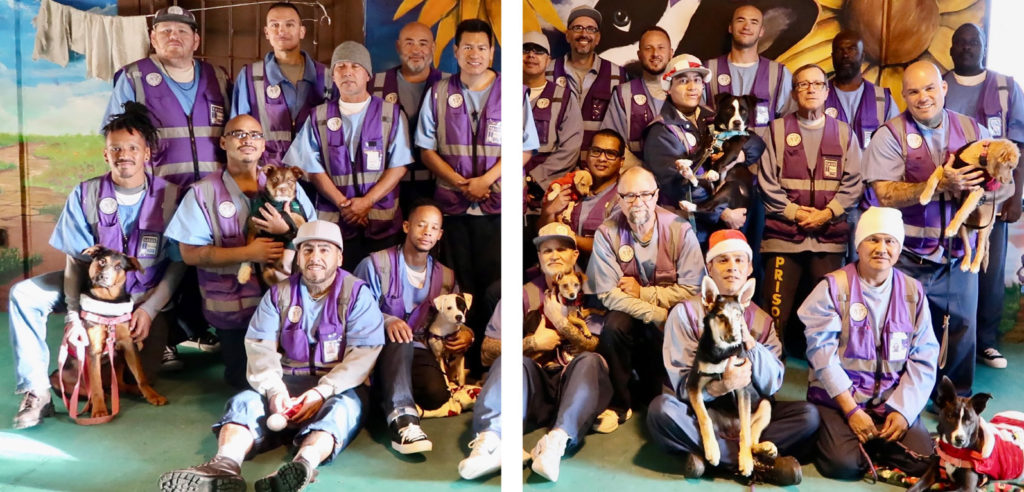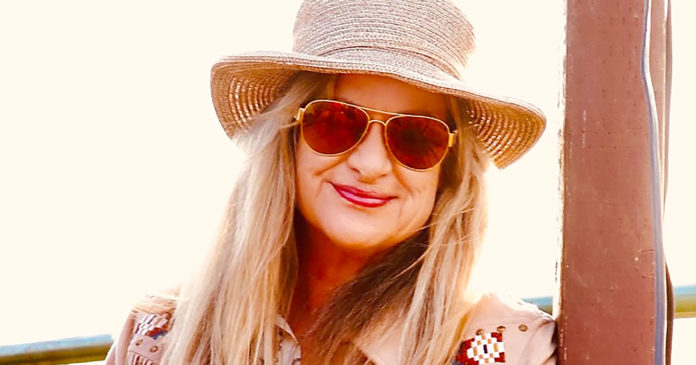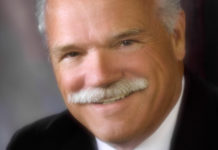The inmate trainers at CTF explained to me that dogs in the TAILS program are immediately crate trained when they arrive in the facility to give them a cozy place to decompress and be safe away from the world. (Except for Sunday, which is a free day for the dogs to sleep in the bunk or by the bunk with a trainer, they are all crated in the training area every night.) This is a good practice protocol for anyone trying to settle a new animal into their home.
Trainer JP had explained to the inmate trainers that it is OK to crate the dogs — “It teaches them how to be alone and how to be calm.” (Though some of the trainers still have issue with the crating thing! “I’ll never accept it,” said Dennis Rock, who is up for parole in March. All the trainers laughed at this.) I asked Dennis if he would have his own dog when he leaves prison. “Oh yes!” he responded enthusiastically. “I love ‘em all!”
The dog learns that their crate is their base, their safe harbor where they can be snug and warm and maybe enjoy a treat in the privacy of their own space. This makes a lot of sense, since the large dorm room is seldom quiet, and the dogs learn to accept their own level of peace in a familiar area. The primary objective, when the dog first enters the facility, is to get them accustomed and accepting of their crate and to work on potty training.
I asked the inmate trainers what the dog-training program had done for them, as we sat in our large group circle, me on a chair and the trainers on the floor. Gabriel told me that he had learned how to be a more patient and giving person in life — traits he had never possessed before. He feels as if, given a chance, having learned how to train dogs in the program, he would also be a better parent to his children on the outside. His children are now adults, and he has hope for his future relationship with them that he didn’t have before.
Correyan said, “There’s a similarity between me and the dogs. I used to be scared, reactive, troubled, just as the dogs can be now when they arrive here. I had a criminal mind set with no empathy, no communication skills in life. I see that now — the dogs have given me a greater appreciation for better things, but it’s not easy. Once you start to change, change is messy!” At this point, Correyan pointed to a sign on the wall close by in the training area:
“Change is hard at first, messy in the middle, glorious in the end,” —Unknown.

The trainers all chuckled at this, as Correyan read it out loud to the group. It was as if they all understood exactly what he was talking about. Training dogs is never easy and always messy — with some wonderful views along the way. The honesty and self-awareness of these inmate trainers was startling to a visitor from the outside.
Victor said it took him 45 years of his 51-year short life to learn how to care and to trust. The dogs and the training program have helped him on the road to better ways, improved feelings, less anger and frustration.
Rolando said, “We see our imperfections and flaws now in a much clearer way. It used to be that everyone else was the problem, not you. Working with the dogs teaches you. I wasn’t born with the issues I came in here with, same as the dog. The dog training teaches life skills. It teaches a mindset of recovery and rehab, which is what we need to get out.”
Tino explained how he witnessed Ruby come into the program as such a scared, abandoned and unwanted little girl. “I watched her settle and grow; her social skills remind me of all the hard work we have put into her growth. You have to trust the process and be proud of yourself and the dog.”
The trainers described how their dog-training efforts translated into reconnections with family members. “My first dog Cayleb was adopted by my sister!” said Chad with a big smile. He is now able to connect with his sister and share the bond of the loving pup that he helped to become a wonderful family member. Orvis explained how his father died and his dog in the program, Shiloh, was then adopted by his mother. “I wanted her to have a piece of this program, a piece of me.”
You don’t need words to describe how reciprocal a program like this can be. “You have to be committed. It’s not easy,” said Rolando. “You have to be determined to do the right thing. We are winning here, and the dogs are winning. We are very grateful that we get to do this.” On coveted family visits within the institution, the trainer can take along their dog. “It makes the visit feel like a proper visit in a proper home,” said Gabriel. “It’s also life-changing for our families to see our dog training skills at work and how far along we have come! It brings them great joy.”
“TAILS in Soledad” will conclude next week.














